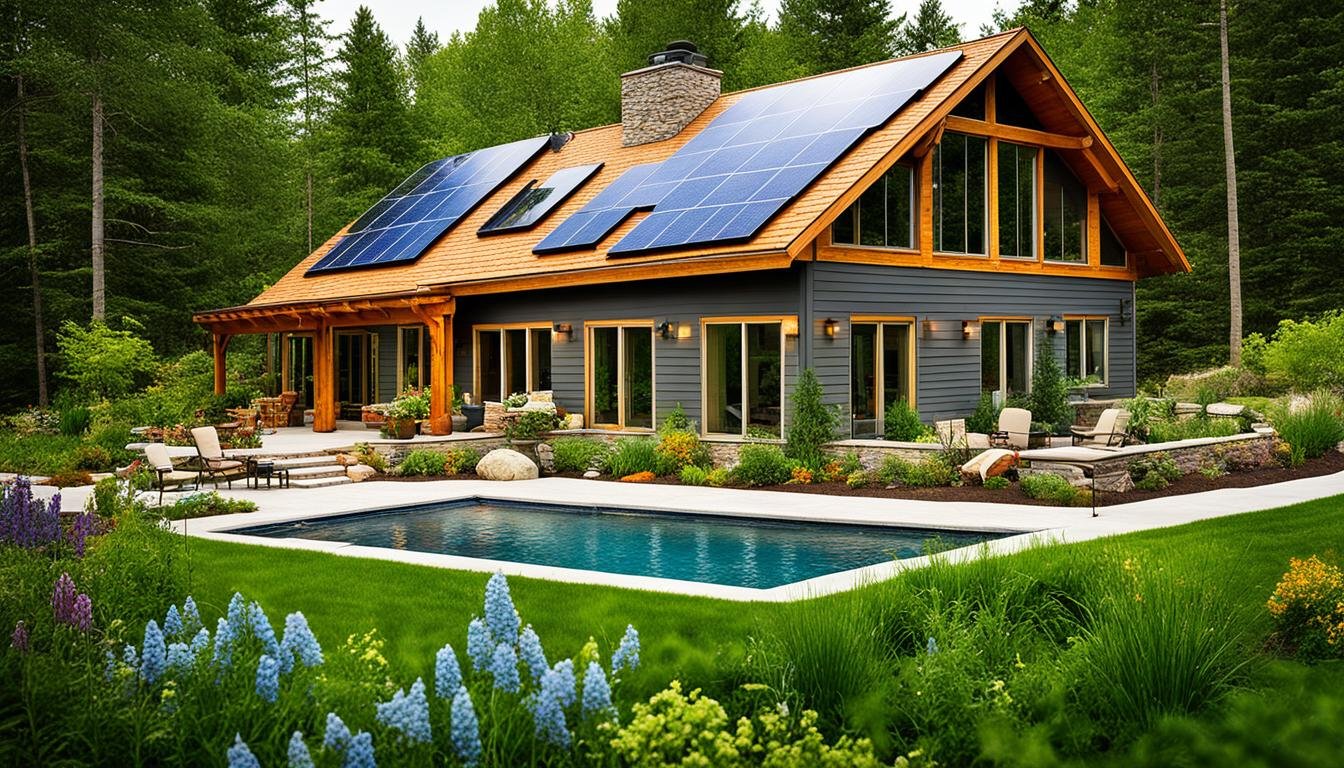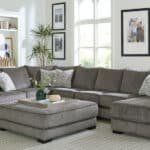Sustainable home design is becoming increasingly popular as homeowners prioritize environmentally conscious living. In this article, we will delve into the beauty of sustainable home design and its positive impact on the environment. By embracing eco-friendly design principles such as sustainable architecture, green building techniques, and sustainable interior design ideas, homeowners can create spaces that are both aesthetically pleasing and eco-friendly.
Key Takeaways:
- Sustainable home design encompasses eco-friendly design principles
- Green building and sustainable architecture contribute to the beauty of sustainable homes
- Sustainable interior design ideas enhance the aesthetics and eco-friendliness of homes
- Embracing sustainable design reduces the carbon footprint and supports a greener future
- Sustainable home design is essential for homeowners who value both beauty and environmental consciousness
The Importance of Sustainable Living
Sustainable living is more than just a trend; it is a way of life that prioritizes our planet’s well-being. By embracing sustainable practices, individuals can reduce their environmental impact and contribute to a greener, more sustainable future. Sustainable living encompasses various aspects, including energy consumption, waste reduction, and living in eco-friendly homes.
One of the key elements of sustainable living is reducing energy consumption. By adopting energy-saving habits, such as turning off lights when not in use, using energy-efficient appliances, and properly insulating our homes, we can significantly minimize our carbon footprint. Small changes in our daily routines can have a significant positive impact on the environment.
In addition to energy conservation, sustainable living involves conscious choices regarding waste reduction and recycling. By reducing our consumption, reusing materials, and recycling whenever possible, we can minimize the amount of waste that ends up in landfills. This helps preserve natural resources and reduces the environmental impact of manufacturing new products.
Living in eco-friendly homes is another crucial aspect of sustainable living. Eco-friendly homes, also known as green homes, are designed and built with environmentally conscious materials and techniques. These homes are energy-efficient, promote healthy indoor air quality, and utilize sustainable resources. From solar panels and rainwater harvesting systems to natural and non-toxic building materials, eco-friendly homes are designed to minimize environmental impact while providing a comfortable and beautiful living space.
The benefits of sustainable living extend far beyond personal satisfaction. By adopting a sustainable lifestyle, we are actively participating in the preservation of our environment for future generations. Sustainable living offers a path to a more resilient and harmonious relationship with nature, fostering a better quality of life for individuals and communities alike.
The Environmental Impact of Sustainable Living
“Sustainable living is not just a choice; it is a responsibility towards our planet and future generations.” – Jane Goodall
Sustainable living has a significant positive environmental impact. By reducing energy consumption, we decrease the demand for fossil fuels and the associated greenhouse gas emissions that contribute to climate change. By using energy-efficient appliances and renewable energy sources, such as solar panels, we can significantly reduce our reliance on non-renewable resources and decrease our carbon footprint.
Through waste reduction and recycling, sustainable living helps reduce pollution and conserve natural resources. By diverting waste from landfills through proper recycling and composting, we minimize the release of harmful substances into the environment and decrease the need for raw materials extraction.
Eco-friendly homes play a crucial role in sustainable living by minimizing their environmental impact throughout their lifecycle. From the sourcing of sustainable materials to their energy-efficient design and construction practices, these homes contribute to a reduced carbon footprint and protect the planet’s natural resources.
By embracing sustainable living practices and living in eco-friendly homes, we can make a positive difference in the world. The beauty of sustainable living lies in its ability to harmoniously integrate environmental consciousness with a fulfilling and comfortable lifestyle.
Sustainable Home Design Trends
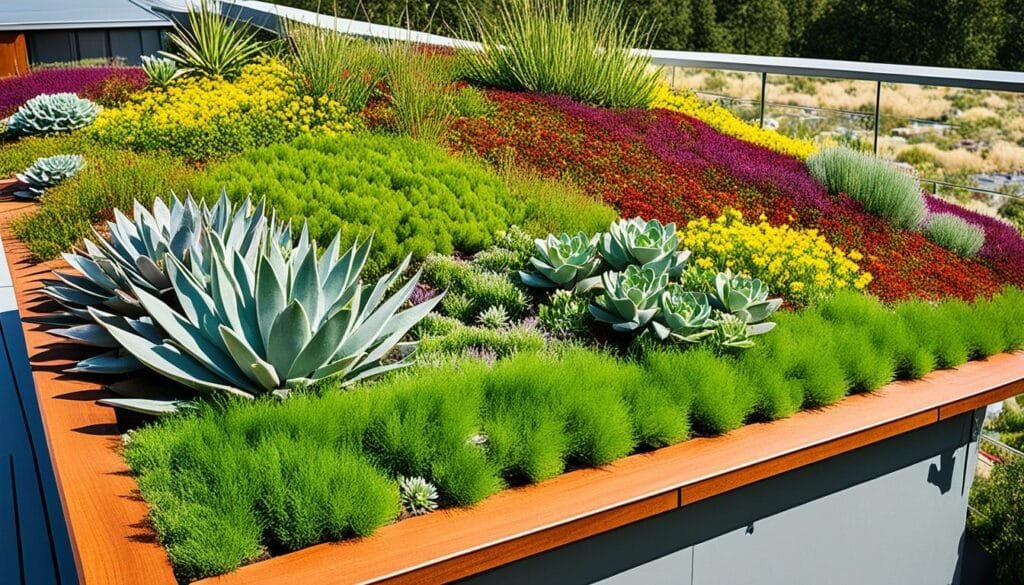
The world of sustainable home design is constantly evolving, with new trends emerging that inspire homeowners to create beautiful and eco-friendly living spaces. Staying up-to-date with these design trends allows individuals to incorporate innovative ideas and sustainable materials into their homes, promoting a greener lifestyle and reducing their carbon footprint. Let’s explore some of the latest sustainable home design trends:
1. Use of Sustainable Materials
One of the key design trends in sustainable homes is the use of eco-friendly and sustainable materials. Homeowners are increasingly opting for materials such as reclaimed wood, recycled glass, and bamboo flooring. These materials not only add a unique and natural touch to the home but also reduce the demand for new resources.
2. Incorporating Green Roofs
Green roofs are becoming a popular design feature in sustainable homes. A green roof consists of a layer of vegetation planted on top of a waterproofing membrane. Green roofs provide numerous benefits such as improving insulation, reducing stormwater runoff, and enhancing air quality. Additionally, they contribute to the overall aesthetic appeal of the home.
“By incorporating sustainable materials and green roofs, homeowners can create not only visually stunning homes but also contribute to the preservation of the environment.” – Sustainable Home Design Expert
3. Promoting Energy Efficiency
Energy-efficient design ideas are another significant trend in sustainable home design. Homeowners are incorporating features such as large windows to maximize natural lighting, efficient insulation to reduce heat loss, and smart home technologies to optimize energy consumption. These design ideas not only lower energy bills but also reduce the reliance on non-renewable energy sources.
4. Utilizing Locally Sourced Materials
An increasing number of homeowners are opting for locally sourced materials in their sustainable home designs. Using materials sourced from local suppliers reduces transportation-related carbon emissions and supports the local economy. It also adds a unique touch to the home’s design by incorporating materials that reflect the region’s culture and aesthetics.
Embracing these sustainable home design trends enables homeowners to create beautiful and environmentally friendly living spaces. By incorporating sustainable materials, incorporating green roofs, promoting energy efficiency, and utilizing locally sourced materials, homeowners can make a positive impact on the environment while enjoying the beauty and functionality of their homes.
Energy-Efficient Home Features
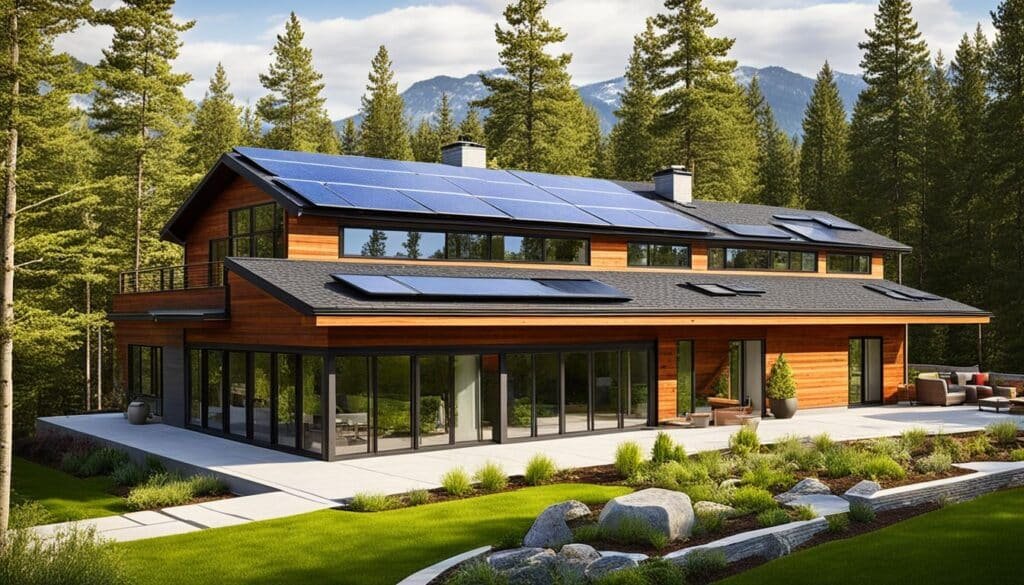
Energy-efficient home features are essential elements of sustainable home design. By incorporating these features, homeowners can significantly reduce their energy consumption and minimize their carbon footprint. Not only do these energy-efficient measures contribute to the overall beauty of the home, but they also offer long-term cost savings and environmental benefits.
Insulation: Keeping the Home Cozy and Energy-Efficient
Insulation plays a crucial role in creating an energy-efficient home. Properly insulated walls, floors, and roofs help maintain a consistent indoor temperature, reducing the need for excessive heating or cooling. This not only lowers energy consumption but also enhances the overall comfort of the living space. Investing in high-quality insulation materials, such as fiberglass or spray foam, ensures optimal energy efficiency and soundproofing.
Energy-Efficient Windows and Doors: Harnessing Natural Light and Minimizing Heat Loss
Energy-efficient windows and doors contribute to both the aesthetics and energy efficiency of a home. These specially designed windows and doors have superior insulation properties and minimize heat transfer. They prevent heat loss during the colder months and keep the home cooler in the summer, reducing the need for constant heating and cooling. Additionally, energy-efficient windows often feature Low-E glass, which allows natural light to enter while blocking harmful UV rays.
Solar Panels: Harnessing the Power of the Sun
Solar panels are a fantastic addition to energy-efficient homes. By harnessing the power of the sun, homeowners can generate clean and renewable energy, reducing dependence on traditional energy sources. Solar panels convert sunlight into electricity, which can power various appliances and systems within the home. With advancements in solar technology, installing solar panels has become more accessible and cost-effective, offering long-term energy savings and a greener lifestyle.
“Energy-efficient home features not only contribute to the overall beauty of the home but also lead to long-term cost savings and a reduced environmental impact.”
Incorporating these energy-efficient home features not only benefits the environment but also leads to significant cost savings over time. The initial investment in insulation, energy-efficient windows and doors, and solar panels pays off in the form of reduced energy bills and a smaller carbon footprint. It’s a win-win situation for homeowners who want to create a beautiful and sustainable living space.
Sustainable Interior Design
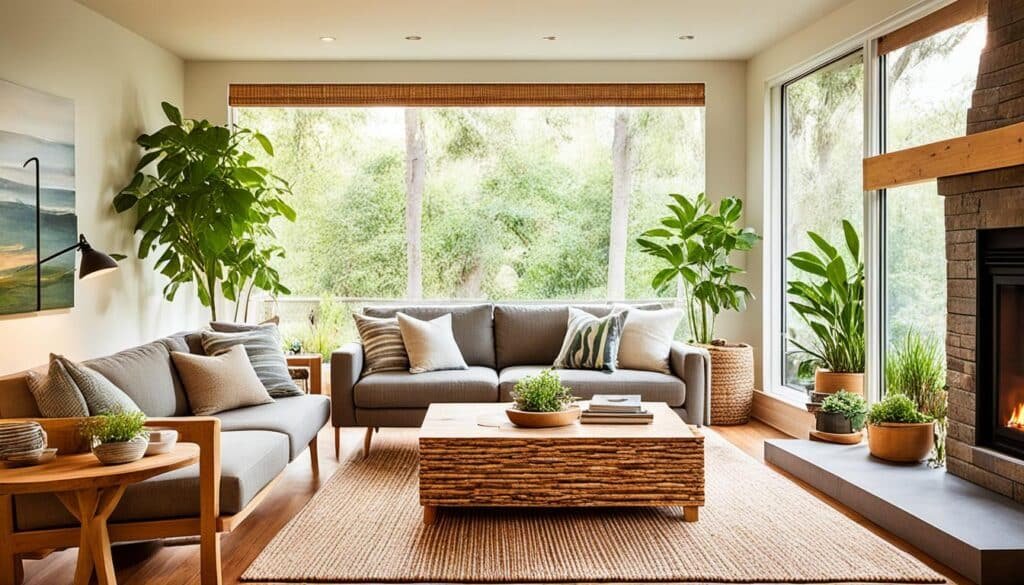
Sustainable interior design offers a unique blend of beauty and eco-friendliness, creating spaces that are not only visually appealing but also environmentally conscious. By incorporating sustainable materials and mindful home decor choices, homeowners can contribute to a more sustainable future while expressing their personal style.
One popular sustainable material that adds character and warmth to any space is reclaimed wood. Reclaimed wood not only reduces the demand for new timber but also gives a second life to materials that would otherwise go to waste. Whether used for flooring, furniture, or accent pieces, reclaimed wood brings a sense of history and sustainability to a room.
Embracing Natural and Eco-friendly Home Decor
When it comes to selecting home decor, opting for environmentally conscious choices can make a significant difference. Sustainable interior design encourages the use of products made from recycled materials, organic fabrics, and non-toxic paints. By choosing eco-friendly home decor items, you not only contribute to a healthier living environment but also support ethical and responsible manufacturing practices.
“Sustainable interior design allows us to create spaces that are not only visually stunning but also mindful of our impact on the planet.”
Creating Sustainable Interior Design Ideas
There are numerous sustainable interior design ideas and practices that homeowners can explore to enhance the overall beauty of their homes. By maximizing natural lighting, integrating energy-efficient lighting fixtures, and strategically placing indoor plants, you can create a space that is both inviting and eco-friendly.
Additionally, incorporating vintage or antique furniture into your interior design not only adds a touch of uniqueness but also reduces the consumption of new materials. Pairing these vintage pieces with eco-friendly upholstery and natural fiber rugs creates a harmonious balance between sustainable practices and stylish aesthetics.
The Beauty of Sustainable Living Spaces
Sustainable interior design allows homeowners to create beautiful living spaces that reflect their values and respect the environment. By utilizing sustainable materials, making eco-friendly decor choices, and embracing mindful design practices, you can transform your home into a sanctuary that promotes both beauty and sustainability.
Sustainable Landscaping
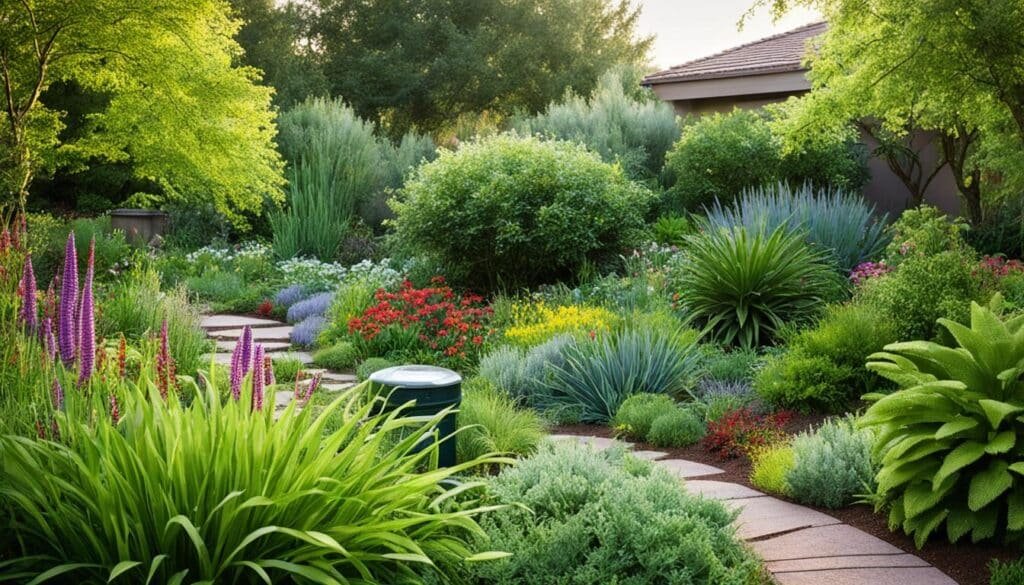
Sustainable landscaping is an integral part of creating a beautiful and sustainable home. By incorporating rainwater collection systems, efficient irrigation methods, and utilizing native plants, homeowners can reduce water consumption and create an environmentally friendly outdoor space. Sustainable landscaping practices enhance the overall beauty of a sustainable home while promoting green living and connecting residents with nature.
Benefits of Sustainable Landscaping
Sustainable landscaping offers several benefits not only to the environment but also to homeowners. By implementing eco-friendly practices, homeowners can enjoy the following advantages:
- Conserves Water: Rainwater collection systems and efficient irrigation methods minimize water usage and support responsible water management.
- Reduces Maintenance: Native plants, well-suited to the local climate, require less maintenance and ensure long-term sustainability.
- Enhances Biodiversity: Incorporating native plants and creating habitats encourages local wildlife, contributing to a healthier ecosystem.
- Promotes Green Living: By adopting sustainable landscaping practices, homeowners actively participate in green living and contribute to a more sustainable future.
Elements of Sustainable Landscaping
To create a sustainable landscape, consider incorporating the following elements:
- Native Plants: Utilize native plants that are adapted to the local climate, requiring less water and maintenance.
- Rainwater Collection Systems: Install rain barrels or cisterns to collect rainwater for irrigation, reducing the need for potable water.
- Efficient Irrigation: Use drip irrigation systems or smart sprinkler controllers to optimize water usage and prevent overwatering.
- Pervious Surfaces: Use permeable materials for driveways, walkways, and patios to allow rainwater to infiltrate the ground, replenishing the water table.
- Composting: Establish a composting system to recycle organic waste, creating nutrient-rich soil for the garden.
By incorporating sustainable landscaping practices, homeowners can create breathtaking outdoor spaces that support both beauty and environmental stewardship.
– Jane Smith, Sustainable Landscaping Expert
Case Study: Green Roof
A green roof is an innovative sustainable landscaping feature that offers numerous benefits. It involves the installation of vegetation on the roof surface, providing insulation, reducing urban heat island effect, and improving stormwater management.
| Benefits of Green Roofs | Examples |
|---|---|
|
|
Sustainable Construction Techniques
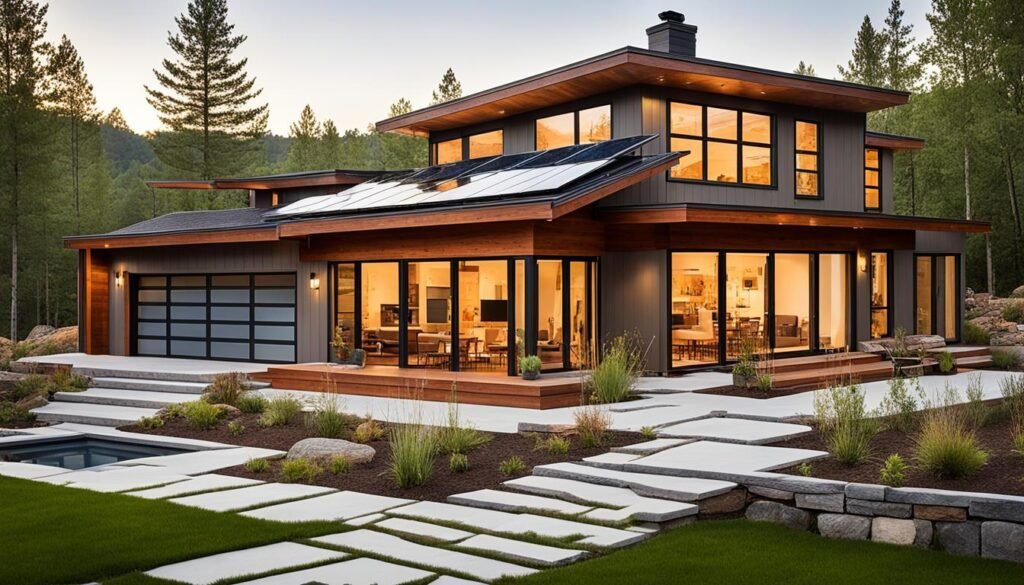
Sustainable construction techniques are vital for building beautiful and eco-friendly homes. By incorporating these techniques, builders can contribute to the overall sustainability and durability of a home while minimizing its environmental impact.
One key aspect of sustainable construction is the use of recycled materials. By repurposing materials such as reclaimed wood or recycled metal, builders can reduce the demand for new resources and decrease waste. Recycled materials not only offer unique textures and aesthetics to a home but also help preserve natural resources.
Using locally sourced materials is another important element of sustainable construction. By sourcing materials from nearby suppliers, builders can reduce transportation emissions and support the local economy. Local materials, such as stone or timber, often blend harmoniously with the surrounding environment, enhancing the aesthetic appeal of the home.
Minimizing waste during construction is crucial for sustainable building practices. By implementing strategies such as proper planning, efficient material usage, and recycling construction waste, builders can reduce landfill contributions and conserve resources. Waste reduction not only benefits the environment but also helps lower construction costs.
Energy-efficient construction techniques are also essential for sustainable homes. Using energy-efficient insulation, windows, and doors can significantly reduce energy consumption and improve the overall energy performance of a home. Incorporating renewable energy sources, such as solar panels or geothermal systems, further enhances the sustainability of the home.
By incorporating recycled and locally sourced materials, minimizing waste, and implementing energy-efficient construction practices, builders can create beautiful and sustainable homes that leave a positive impact on the environment.
Benefits of Sustainable Construction Techniques
- Reduction of environmental impact
- Preservation of natural resources
- Support for local suppliers and economies
- Lower energy consumption and utility costs
- Improved energy performance and comfort
- Long-term durability and resilience
By adopting sustainable construction techniques, builders can contribute to the overall beauty and sustainability of a home. These practices not only prioritize the environment but also create comfortable and long-lasting living spaces for homeowners.
Net Zero Homes
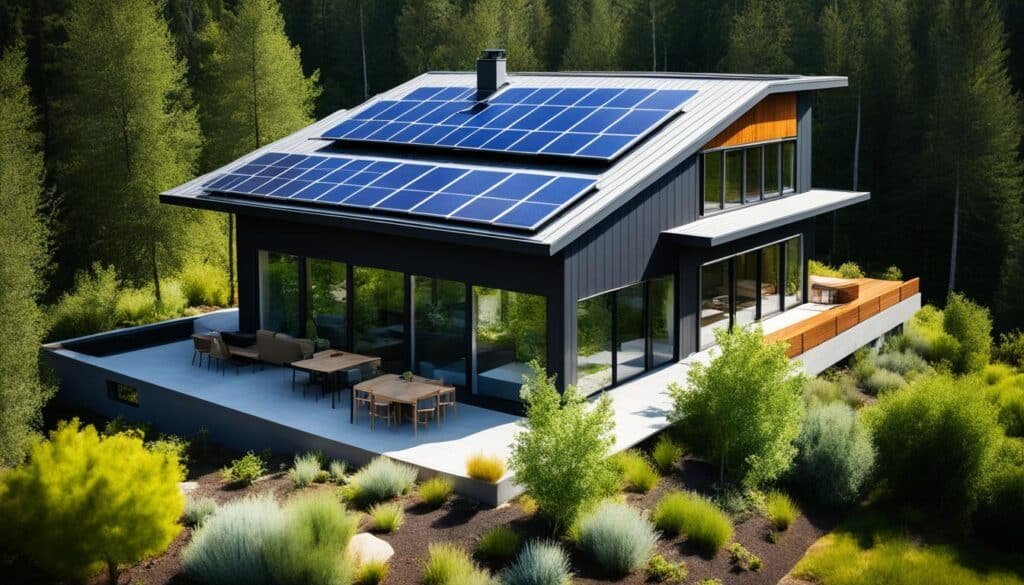
Net zero homes represent the pinnacle of sustainable home design, combining energy efficiency and renewable energy sources to achieve zero net energy consumption. These homes are meticulously designed and built with the aim of producing as much renewable energy as they consume. By incorporating advanced insulation techniques, energy-efficient features, and renewable energy systems like solar panels, net zero homes significantly reduce energy consumption and utility bills.
Net zero homes contribute to the beauty and sustainability of home design by providing not only an environmentally conscious living space but also long-term cost savings for homeowners. By minimizing energy usage and relying on renewable energy sources, net zero homes make a positive impact on the environment and offer a comfortable and energy-efficient living environment for occupants.
Investing in a net zero home not only reduces the ecological footprint but also offers numerous benefits to homeowners. The lower energy consumption, achieved through energy-efficient features and renewable energy systems, leads to substantial savings on utility bills. Additionally, the advanced insulation techniques used in net zero homes provide a comfortable indoor environment year-round, regardless of external weather conditions. These features, combined with the eco-friendly design elements, contribute to the overall beauty and desirability of net zero homes.
Embracing the concept of net zero homes is an effective way to create a future that is both sustainable and aesthetically appealing. Through innovative energy-efficient design and the integration of renewable energy systems, net zero homes make a significant impact in reducing energy consumption and dependence on non-renewable resources. This not only benefits individual homeowners but also contributes to a greener and more sustainable world for future generations.
Benefits of Net Zero Homes
Net zero homes offer a range of benefits that go beyond energy efficiency and utility bill savings. Here are some key advantages:
- Reduced carbon footprint: Net zero homes help combat climate change by minimizing greenhouse gas emissions and reliance on fossil fuels.
- Improved indoor air quality: The advanced insulation and ventilation systems in net zero homes enhance indoor air quality by reducing infiltration of outdoor pollutants.
- Enhanced home value: Net zero homes are highly desirable in the real estate market due to their energy efficiency and sustainability, often resulting in increased home value.
- Resilience and energy independence: The integration of renewable energy sources in net zero homes provides resilience against power outages and reduces dependence on the electrical grid.
- Innovative technology: Net zero homes often incorporate cutting-edge technology and smart home features that enhance convenience and optimize energy usage.
Net Zero Home in Action
| Energy Consumption | Energy Usage | Utility Bills |
|---|---|---|
| Minimized through advanced insulation and energy-efficient appliances. | Optimized through intelligent control systems and smart home technology. | Significantly reduced or eliminated by utilizing renewable energy sources. |
The Use of Sustainable Materials
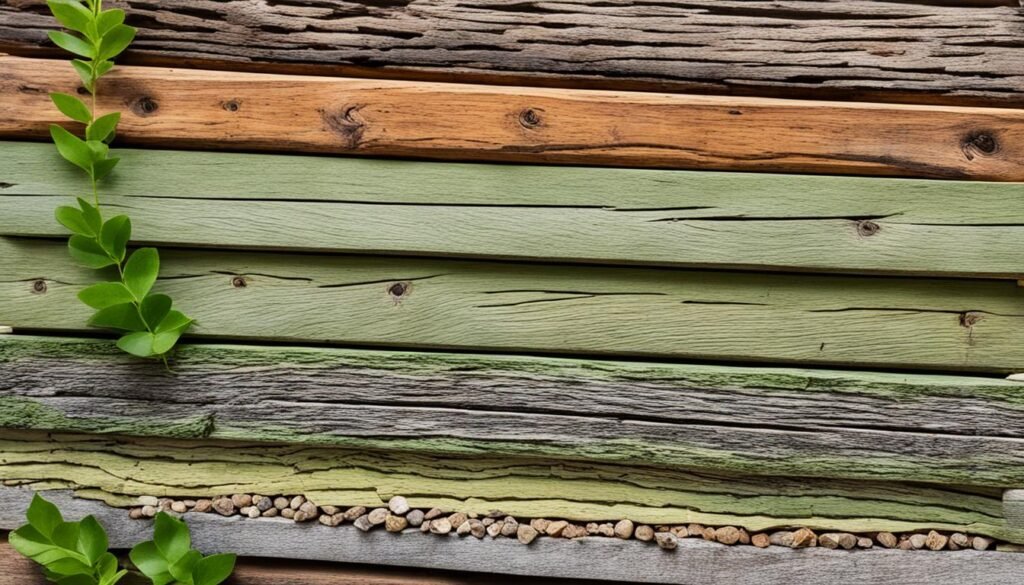
Creating beautiful and sustainable homes involves the thoughtful selection of materials. By opting for sustainable materials, homeowners can contribute to the overall beauty and sustainability of their homes while reducing their environmental impact. Sustainable materials are those that are responsibly sourced, recycled, or repurposed, aligning with the principles of green building and environmentally friendly design.
One popular sustainable material choice is reclaimed wood. This type of wood comes from old buildings, barns, or other structures and is repurposed for new construction or interior design. Using reclaimed wood not only adds a touch of uniqueness and character to a home’s design but also reduces the demand for new timber, helping to preserve forests and support sustainable forestry practices.
Another option is incorporating recycled materials into home construction and design. These materials, such as recycled glass or metal, are processed or transformed from their original form to create new products. By using recycled materials, homeowners can divert waste from landfills and minimize the extraction of raw materials, conserving natural resources in the process.
Choosing environmentally friendly products is also essential in sustainable home design. These products are made using sustainable manufacturing methods and materials that have a minimal negative impact on the environment. From flooring made of bamboo, a fast-growing and renewable resource, to paint with low volatile organic compound (VOC) content, there are various eco-friendly options available for homeowners to incorporate into their homes.
Benefits of Sustainable Materials:
- Reduced environmental impact: Sustainable materials minimize the depletion of natural resources, reduce waste, and lower carbon emissions associated with production and transportation.
- Unique aesthetics: Reclaimed wood and other sustainable materials add character and a sense of history to home design, creating a unique and visually appealing space.
- Healthier indoor environment: Many sustainable materials, such as low VOC paints and flooring, contribute to better indoor air quality, promoting the health and well-being of occupants.
- Support for local communities: Choosing locally sourced sustainable materials supports local economies, reduces transportation emissions, and fosters a sense of connection to the community.
By consciously selecting sustainable materials, homeowners can create beautiful spaces that not only showcase their personal style but also preserve the environment for future generations.
Conclusion
The beauty of sustainable home design lies in its harmonious blend of aesthetics and environmental consciousness. Homeowners who incorporate sustainable construction techniques, energy-efficient features, and sustainable materials have the power to create stunning homes that not only captivate the eye but also make a positive impact on the environment.
Sustainable design features, such as energy-efficient windows, green roofs, and reclaimed wood accents, contribute to the overall beauty of sustainable homes. These design elements not only enhance the visual appeal but also promote green living by reducing energy consumption and utilizing eco-friendly materials.
Embracing the principles of sustainability in home design is an essential step towards creating a better future for both homeowners and the planet. By being environmentally conscious and incorporating sustainable design features, homeowners can create breathtaking spaces that foster a greener lifestyle. The beauty of sustainable home design lies not only in its aesthetic appeal but also in its contribution to a more sustainable and eco-friendly world.
Also Refer : Building A Home: Simple Steps To Follow
FAQs
Q: What is sustainable home design?
A: Sustainable home design involves creating homes that are environmentally friendly, energy-efficient, and built using recycled and locally sourced materials to minimize environmental impact.
Q: How important is sustainability in home design?
A: Sustainability is essential for sustainable home design as it focuses on reducing energy use, utilizing eco-friendly building materials, and promoting a healthier living environment.
Q: What are some key elements of sustainable home design?
A: Key elements of sustainable home design include using recycled materials, incorporating energy-efficient systems, utilizing passive house principles, and considering the environmental impact of building materials.
Q: How can architects incorporate sustainability into home designs?
A: Architects can integrate sustainability into home designs by prioritizing energy efficiency, utilizing eco-friendly building materials, and considering the life cycle of the building in their architectural plans.
Q: What role do prefab homes play in sustainable design?
A: Prefab homes can contribute to sustainable design by reducing construction waste, utilizing efficient building methods, and incorporating energy-saving features into their design.
Q: How can homeowners contribute to sustainable home design?
A: Homeowners can contribute to sustainable home design by choosing energy-efficient appliances, implementing water-saving fixtures, and considering eco-friendly building materials for remodeling or building projects.
Q: Why is sustainable home design beneficial for the environment?
A: Sustainable home design is beneficial for the environment as it reduces energy consumption, minimizes waste, promotes the use of renewable resources, and prioritizes environmental conservation.
